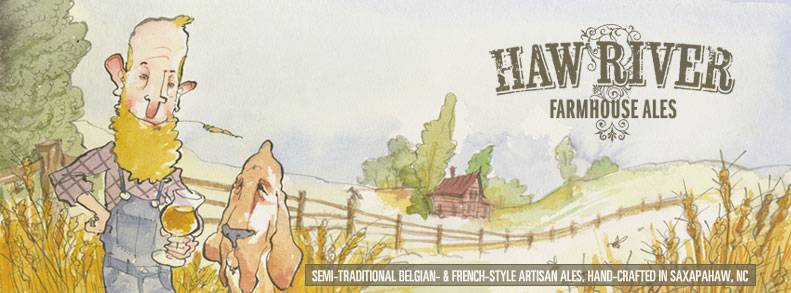Recently, we were lucky enough to have been invited to pour at Homebrewed Raleigh, alongside our friends at Carrboro's very own Steel String Brewery and a number of awesomely talented homebrewers from around the Triangle area. During the second session of the event, an enthusiastic couple came by our table to try the beer we were pouring (we brought a cask of our Farmhouse IPA, a hoppy Witbier and a special Spring version of our Saison, made with locally-malted barley from our friends at Riverbend Malt House in Asheville, NC) and mentioned they'd read the earlier blog post about our little experiment. As the conversation continued, we learned that one of them currently works at a local university as a research specialist, spending a majority of her time watching yeast cells under a microscope (serendipity is a clever creature sometimes, no? :) After hearing her questions and concerns about what we had planned (I believe her words were along the lines of "you'll want to try not to kill anybody with that..." but I digress), we decided it made a bit more sense to have our new friend take a look at our collected samples and give us her feedback and advice.
 |
| Each of the four vials were collected from spots around Saxapahaw, NC a few months ago. |
So here's a little update on where we are with the experiment these days. Last weekend, we handed off 4 vials of our wild yeast cultures to our new friend, so she can plate each of them, freeze down a sample on a variety of media, and then move forward isolating individual strains that potentially exhibit the qualities we're looking for in a brewer's yeast (the amount of sugar the yeast will eat [called "attenuation"], the alcohol tolerance of the particular strain, the ability for it to clump together and fall out of solution [called "flocculation"] after it's done doing its thing...). Right now, there exists in each vial a miasma of all kinds of living beasts (some friendly, some a bit more dastardly), so it's important to try to grow up single colonies of yeast cells in an effort to tell them apart and separate each of them into individual "neighborhoods", so we can really see what we're looking at, and (down the road) pitch the right amounts of each type into the beer we're making. Did I mention I'm glad we now have help with this?
 |
| This is an example of Brettanomyces Bruxellensis, one of a many organisms we're hoping to find in our samples. |
Once the strains are isolated and we can actually take a look at pure cultures, we're going to get DNA sequenced for the ones we want (so we can potentially identify them and match them up with existing strains), then pull a few into a very simple beer recipe (90-100% base malt, with a little specialty malt thrown in for a bit of body & sweetness, depending on the types of yeast we end up with and are testing out). These will be split evenly into a number of small fermenters, so we can let the aroma and flavor qualities of the yeast shine and see what we've got. We'll ferment the beer out and measure the sugars, and then analyze the results from a number of angles.
If we end up with an appealing outcome, we're hoping we can bank the yeast(s) with a service such as the one White Labs offers, and then be able to order that particular strain whenever we want to brew a new batch of a particular style. It'll be like having our own unique library of Saxapahaw yeast to use for the beer we make!
A secondary goal we have is to be able to gather data on what true spontaneous fermentation here in central North Carolina might look like, and then collect the data we need to attempt to control certain aspects of the process for a future batch of wild fermented lambic. But coolships and spontaneous fermentation is a subject worthy of another blog post. Stay tuned, folks—this is getting fun. ;)

Hi Ben,
ReplyDeleteJoel McClosky of Four Saints Brewing sent me the link to this blog. I mentioned to him yesterday that I was working towards this goal myself. I have a brewing student who is a microbiologist who is interested in working together with me to make progress. Last year I did a spontaneous fermentation with muscadines down here in Star, NC and it actually came out delicious and 11% ABV. While it was actively fermenting I stole some liquid from the jug and innoculated some beer wort and the resulting beer was also tasty. At this point that yeast if probably useless, so I plan to do that again this season and go through the process of plating out some samples, isolating cells, making batches, applying selective pressures such as higher alcohol, top cropping, different ferm temps, and so on. Why not, right? Is there any way we could or should be working together? Or maybe it's cool to work separately but keep each other posted as to what we're each doing.
Thanks for putting the blog up!
Eddie Bernard
Hey Eddie. Thanks for chiming in. I love the fact that you've been tinkering with this as well — if the yeast we've got going so far turns out the way I'd like, it'll be an interesting extension of the project to try to bank it and have it at our disposal for batches "on demand" in the future. Once we get a pitchable quantity of yeast, I'll be happy to send a vial your way for experimentation (or trade it for a vial of yours). Have you actually gone so far as sequencing the strain you isolated? Any idea what it was? Exciting stuff, either way!
ReplyDelete